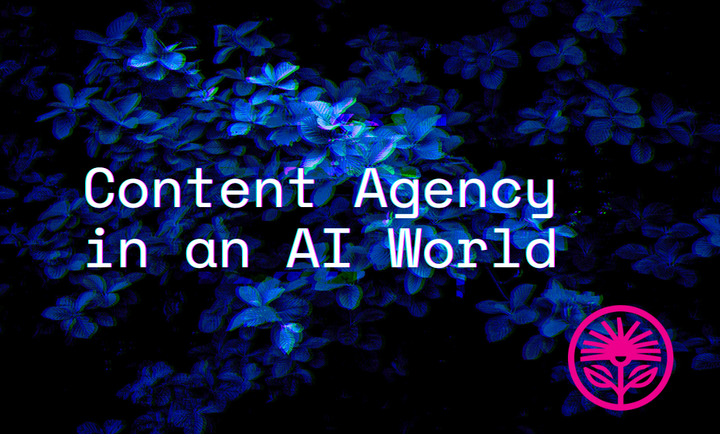Kelford Labs Weekly: Everyone has the same bright idea
AI doesn’t make you special. You do.

“Once you have a way in which things are done, the edge migrates. Goes elsewhere.”
— William Gibson, Zero History
A fragment of a memory from a comic book has stalked me since my childhood.
As a kid, I read a lot of comics, from hand-me-down Archie anthologies to my coveted Calvin & Hobbes. Heck, I was even known to ride my bike down to the corner store to spend my paper route money on the odd MAD Magazine (he says, oldly).
One night, reading comics before bed, I came upon a series of panels that would stick with me forever.
I don’t remember the actual comic book they appeared in, or even the setup for the joke. But here’s what lodged into my brain:
The “reasonable” character in the story (maybe it was Archie, maybe it was Calvin’s dad?) suggests to the group that they should head out early to their destination to “beat the crowds.”
The punchline, delivered a few panels later, is the group arriving at their destination to see that a large crowd has already formed.
The snarky character (maybe it was Jughead, maybe it was Calvin or his mother), turns to the reasonable one and says,
“Looks like everyone else had the same bright idea.”
All the Googling in the world hasn’t helped me track down what the actual comic was, or the context in which the joke was told.
But that idea—that when we try to beat the market by doing something anyone else could do, too, we’ll likely end up realizing that everyone else had the same bright idea—has never left my mind.
So, this is a post about AI.
What’s the Bright Idea?
“You can no longer trust that anything you see, or hear, or read was not created by AI.
…
Humans, walking and talking bags of water and trace chemicals that we are, have managed to convince well-organized sand to pretend to think like us.”
— Ethan Mollick, Co-Intelligence
The current “bright idea”, as far as I can see it, is using AI to generate your marketing content.
Maybe it’s blog posts or newsletters. Maybe it’s LinkedIn comments or Threads. Maybe it’s your SEO descriptions or even your homepage copy.
The concept is the same: Attempting to get a competitive edge by doing the exact same thing that everyone else is doing. Not beating the crowd, but forming a part of it.
As the old saying goes, “You’re not stuck in traffic. You are traffic.”
If you’re currently using AI to do your marketing content, there are a few questions I invite you to ask yourself to know whether you’re going to beat the crowd or join it:
1) Do I have access to a uniquely capable or powerful AI tool that nobody else has?
2) If not, am I uniquely skilled at instructing the AI tool to create uniquely valuable insight?
3) If not, why would anyone read my AI writing instead of someone who can answer Yes to the above questions?
As Archie or Calvin or whoever once told me, it’s not a bright idea if everyone’s having the same one, at the same time.
And it’s certainly not a bright idea if people are having better ideas.
Consistency is Commodity
“Where the product or service is perceived as a commodity or near commodity, choice by the buyer is largely based on price and service, and pressures for intense price and service competition result.”
— Michael E. Porter, Competitive Strategy
The thing is, our prospects want to be confident that we’re credible. That we’re uniquely capable of solving their problem or providing a service or delivering a product.
Which means it’s our job in marketing to demonstrate that value—that credibility—to them at a distance, as best we can.
If GPT is already doing that work for us, what are we doing? Are we demonstrating our value or OpenAI’s?
Look, I know that everybody uses GPT to help with their writing, to fix their mistakes or look for opportunities to dig deeper. That’s one thing.
But having it generate our ideas or our content whole cloth is begging to be disrupted by the first person who doesn’t do that. It’s asking to be commoditized, to be considered just another one in a growing set of generic options.
Not because GPT or Claude or Gemini are bad writers, but because they’re good. They’re so good that everyone’s using them.
And you see AI content everywhere now. The crowd has already arrived.
And they’ve turned content—the written word to the moving image—into a commodity. Something that a few keystrokes, a few bucks—and more water than one wants to think about—can just churn out at the speed of 800 tokens per second.
That’s roughly a page of content, every single second.
“Content” used to be a differentiating factor. Now, on its own, it’s only as valuable as the paper it isn’t printed on.
A Brighter Idea
“A fad is a wave in the ocean, and a trend is the tide. A fad gets a lot of hype, and a trend gets very little.”
— Al Ries & Jack Trout, The 22 Immutable Laws of Marketing
So, what, we should just give up?
No, we should stand out.
Doing what everyone else is doing is the opposite of marketing. It’s business camouflage.
Doing what nobody else is doing is the whole point of having a business. The point is to offer value that people can’t get anywhere else—otherwise, why would we spend the time, effort, and energy it takes to be an entrepreneur?
So when it comes to demonstrating that value, we need to remember it’s still about doing things nobody else can do.
It’s still about standing out and being unique.
Back to our three questions, with a twist. Let’s now ask ourselves:
1) Can I get access to a uniquely capable AI tool or process?
2) Can I become uniquely skilled at using AI in a way nobody else can?
3) Why would somebody read my content instead of someone else’s?
So, first up, if you’re going to use AI, are you using the exact same tools as everyone else? Are you at least paying a few bucks a month to have access to the leading models (like GPT-4 Turbo or Claude Opus) instead of relying on the free options with hundreds of millions of active users churning out commodity content?
Next, how are your prompts and grounding (unique data)? Are you guiding the AI to produce something extraordinary, based on your unique insights, experiences, or expertise? Are you providing it with fresh ideas—novel tokens—it can base its response around to set it apart? Or is it possible someone else, right now, is asking the tool for the exact same thing you are, in the same way?
If your prompt—the input—isn’t unique and special and something only you could ask, the output won’t be either.
(Remember your privacy and confidentiality! If you give data to an LLM, you’ve got to assume they’re gobbling it up and spitting it out to everyone else. So, keep what’s confidential and private to yourself and don’t trust an investor-driven business to keep their promises.)
Finally, we’ve got to know why somebody would prefer our content over someone else’s.
What do we know that nobody else knows? What have we done that nobody else has? What can we do that nobody else can?
Remember: the question of why you’re valuable is answered by knowing why you’re unique.
The Best Idea
“If you aren't different, you have no identity. You're just a commodity. Just a manufacturer in fact, you have no brand. So to have a brand you need an identity. To have an identity you need a point of difference. And if you don't have one, you need to create one.”
— Dave Trott, Creative Mischief
Of course, there’s an even better approach that’s worth considering, if you can:
Not using AI. Or, at least, not having it do your thinking for you.
Look, I use AI in my personal life for lots of different applications and processes. I’ve created dozens of AI “Assistants” via Open AI’s APIs that update me on the news every morning, let me search the web via voice with customized responses, and teach me about the films I’m watching and the books I’m reading.
I am (somewhat ashamedly) a fan of some of the current crop of AI tools.
But what they don’t do is my writing for me. Because, if they did, I wouldn’t get any better. I wouldn’t get any smarter. I wouldn’t get any closer to my readers.
And I wouldn’t be able to answer the question: Why would someone read my content instead of somebody else’s?
But because you and I both know that my content comes from 20 years of marketing experience, thousands of client interactions, and millions of words written on the subject already—there’s a reason to read what I write.
Because nobody else could write it, in exactly the same way I can.
So ask yourself the same question: What do you know, what have you done, what have you experienced that makes you uniquely capable of doing what you do best?
Because that’s also the answer to what content you’re able to create that nobody else can.
Demonstrating value and delivering value are two sides of the same coin: The value is the same.
The value is whatever makes you, you.



